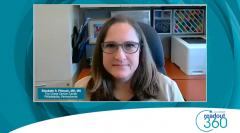
Updates from ASCO 2023: KEYNOTE-B61 Study in Non-Clear Cell Renal Cell Carcinoma
Switching its focus to non-clear cell RCC, the panel reviews data presented at ASCO 2023 on KEYNOTE-B61, combining lenvatinib + pembrolizumab in this setting.
Episodes in this series

Transcript:
Brian I. Rini, MD, FASCO: Thank you all for that. I’m going to talk a little bit about some non–clear cell updates from ASCO [American Society of Clinical Oncology], and then we’ll discuss. So, in non–clear cell, we tend to develop drugs in clear cell and borrow them for non–clear cell, usually with limited data. Sometimes some phase 2 trials that we’ll talk about. A clinical trial is always on the list for non–clear cell. Single-agent TKI [tyrosine kinase inhibitor], namely cabozantinib, has been a standard and then there [are] some emerging data with the immune-based doublets. So, let me present some of these results and…I’d be interested how you each approach non–clear cell.
So…Joe Lee[, MD,] from Memorial [Sloan Kettering Cancer Center] presented an update of this KEYNOTE-B61 study [NCT04704219]. So, this is...probably the largest non–clear cell trial ever done to my knowledge. It was a single-arm trial in metastatic non–clear cell, which as you all know, includes a variety of histologies: papillary, unclassified chromosome translocation, etc. And it was the same dosing schedule of len/pembro [lenvatinib/pembrolizumab] that we’ve been talking about, 20 mg lenvatinib and standard pembrolizumab dosing, mostly looking at response rate, capturing other end points, but really just looking at the activity of this regimen. I was pretty impressed with these data. The PFS [progression-free survival] is nearly 18 months...that’s probably one of the longest we’ve seen in non–clear cell to my knowledge, maybe the longest. Not quite as long as the nearly 2 years we saw in clear cell, but it’s pretty darn good. Good overall survival. A little hard to tell that in a single-arm trial. And also, high response rates across the histologies. So maybe I’ll pause there. Bob, let’s start with you. How do you approach [this]? You were obviously part of this trial. How do you approach non–clear cell in general? Is len/pembro preferred based on these data?
Robert J. Motzer, MD: I think localized therapy is key for non–clear cell…because of the relative lack of responsiveness we’ve had historically. So, localized therapy with SBRT [stereotactic body radiotherapy], with mastectomy, we often consider those early and try to hold off on therapy. For the most part, as you mentioned, the therapies have been extrapolated over from that which we use in clear cell and at least with the TKIs, [we] don’t have much of a rationale with the exception perhaps of cabozantinib in papillary carcinoma. So...it’s been more or less sunitinib or cabozantinib [that] really emphasize a clinical trial. And...I do think there is activity in IO [immune-oncology] for most tumor types with the exception of chromophobe, at least as a single agent. And so, I wasn’t surprised that there is a higher level of activity with the TKI and IO compared to what we’ve seen previously with TKI, whether that’s the direct effect of the TKI on the tumor or whether that’s the TKI augmenting the immune effect…of the PD-1 inhibitor, not clear to me. But for the most part…outside a protocol, I have been using cabo/nivo [cabozantinib/nivolumab] and...once [these] data [are] published and perhaps in favor of the NCCN [National Comprehensive Cancer Network], I’ll start using len/pembro.
Brian I. Rini, MD, FASCO: OK. Betsy, what do you think? What’s your approach to non–clear cell?
Elizabeth R. Plimack, MD, MS: I’m compelled by these data. As we know, non–clear cell is a variety of diseases. The most common is papillary. We see that pretty frequently based on these data. This is now my first-line regimen, pembrolizumab with lenvatinib for papillary renal cell carcinoma. For chromophobe…the science…it’s a cold tumor. We don’t typically see markers of responsiveness when we sequence these tumors. For anyone with…PD-L1 positive and chromophobe, and I’ve had a few...this combination makes sense. Otherwise, I still would probably lean on single agent for those folks. Part of it is they’re on it for a very long time because chromophobe grows slowly and responds slowly. And so, you’re really looking at the long term when you’re looking at therapy for a patient with chromophobe.
Brian I. Rini, MD, FASCO: Yeah. Moshe, how do you approach these folks?
Moshe C. Ornstein, MD, MA: It’s interesting. The [patients with] chromophobe...come in 3 flavors. There’s the really aggressive, rapidly progressive metastatic disease. And those patients...I give them an IO TKI now, either the lenvatinib/pembrolizumab or cabo/nivo. I worry about giving them a single agent of anything, if they’re that rapidly progressive, especially with these response rates that we’re seeing. The other chromophobe population is metastatic disease, but a more slowly growing metastatic disease, but still a metastatic disease that we need to treat. And then the last population that I see a fair amount of is nephrectomy, a couple of years later, a lesion where they have a mastectomy then maybe SBRT a couple of years later. So, it’s a metastatic disease where…as Bob said, the key is really local treatment.
So, for chromophobe...these patients are really all over the map. But if it’s slower growing, I might give them lenvatinib and everolimus. If it’s more rapidly progressive where I really want to shoot for that higher response rate that we’re seeing with these IO TKI regimens, I’ll give them an IO TKI. But for patients with metastatic papillary, I’ve been giving them cabozantinib and nivolumab. Really, I’ve been giving the cabo based on the…study of cabozantinib as “superior” at least to the drugs…it was compared to in the study from a TKI perspective. So, I was giving cabo/nivo, but I’m comfortable giving either cabo/nivo or lenvatinib with pembrolizumab. However, I do think that patients in general with metastatic papillary RCC [renal cell carcinoma] should get an IO TKI regimen.
Transcript is AI-generated and edited for clarity and readability.
Newsletter
Stay up to date on recent advances in the multidisciplinary approach to cancer.
























































































